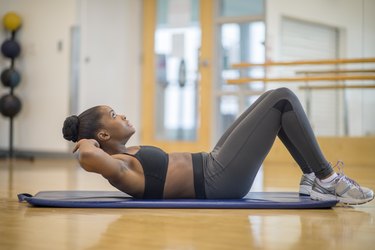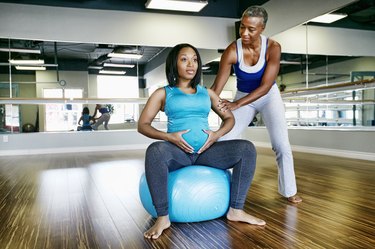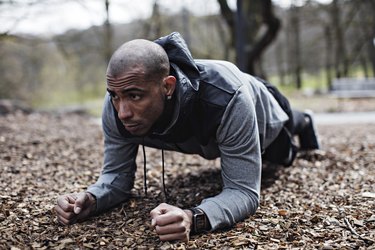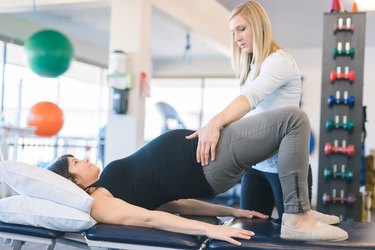
Seeing your stomach muscles protrude when doing sit-ups can be alarming, especially if there are more than one. So, if you're wondering, why do my abs stick out when doing this exercise, there are two likely causes for these protrusions: diastasis recti or a hernia.
Diastasis recti is a separation of your abs that often occurs during the third trimester of pregnancy and after postpartum, per the Cleveland Clinic, but can also be due to lifting heavy weights or rapid weight gain. A hernia is a bulge that is due to a weakness in the wall of your abdominal tissue, per the Cleveland Clinic.
Video of the Day
Video of the Day
Both conditions aren't a sign of a serious health issue, but it's still important to talk with your doctor for a diagnosis and treatment plan.
Below, we'll get into the specifics of how to identify, treat and prevent both diastasis recti and hernias so you can get back to doing sit-ups — and your other favorite exercises — worry-free.
Diastasis Recti
What Is Diastasis Recti?
Your abs are divided into a left and right side. The linea alba connects these two sides, and when under stress, it thins and widens the gap, resulting in a bulge in the center of the stomach, according to the Cleveland Clinic.
Diastasis recti can make you look pregnant long after having your baby. It also shows up as a football-shaped dome that causes a bulge in the middle of your stomach when you're doing sit-ups and other abs exercises.
Identifying Diastasis Recti
Diastasis recti isn't typically painful, per the Cleveland Clinic, but "you may feel weakness in your core when doing once easy tasks, like lifting a laundry basket. Some people feel a jelly-like texture in the space between the left and right abdominals when contracting the ab muscles."
You should get a doctor's confirmation that you have diastasis recti and not a hernia, but there's also a self-test you can perform, according to the Cleveland Clinic.
Lie on your back with your knees bent and your feet planted on the floor. Place one hand on your belly and put your finger right at your navel. Press your fingers down and lift just your head and neck up as if you were starting a crunch. Feel for a space between the two sides of your rectus abdominis, the front abdominal muscle.
You likely have the separation if you feel a finger's width or more distance between the two sides of the muscle.
Treatment for Diastasis Recti
Diastasis recti is a benign condition, meaning it doesn't immediately affect your health. In rare cases, however, surgery is required to repair the gap, but usually you can pull the muscle back together with deliberate exercises. Regardless of the severity of your diastasis recti, it's important to talk to your doctor to come up with a treatment plan.
Some exercises, including sit-ups, make the gap worse (more on that below), so do other types of exercises instead:
- Squat with a ball: Place an inflated mini exercise ball — about the size of a soccer ball — between your thighs and squeeze as you squat.
- Bracing: Sit in a comfortable position and place your hands on your abs. Breathe normally as you pull the ab muscles in toward your spine. Hold for 30 seconds.
- Bridging: Lie on your back and bend your knees with your feet planted hip-distance apart. Squeeze your abs in as you lift your hips up to create a line from your knees to your shoulders.
- Leg slides: Lie on your back with your knees bent and feet planted. Draw your navel in toward your spine as you slide your right leg out straight on the mat. Use control to pull it back in and repeat with the left leg. Alternate for the desired number of repetitions.
In many cases, diastasis recti heals on its own and needs no specific intervention.
Warning
If you're pregnant or postpartum, get clearance from your doctor before starting an exercise program.
Prevention for Diastasis Recti
To reduce your risk of developing diastasis recti, there are a few things you can do, according to the Cleveland Clinic:
- Avoid certain core exercises: Crunches and sit-ups can put pressure on your abs after 12 weeks of pregnancy and postpartum. Doing moves like planks (or modified planks), farmer's carries or glute kickbacks during your pregnancy are typically safe, but it's important to chat with your doctor to figure out the best workout plan for you.
- Maintain proper posture: It's best to stand up straight with your shoulders back as much as you can.
- Practice deep breathing: Take deep breaths that allow your ribs to expand — not just your stomach.
- Don't put unnecessary strain on your abs: Take special care when performing day-to-day activities like lifting heavy bags or boxes, pets, children, etc.
- Use caution when getting out of bed: If you're pregnant or postpartum, it's best to roll to one side and use your arms to push yourself up out of bed.
Hernias
What Is a Hernia?
A hernia can occur anywhere in the body but happens most often in the abdominal area, particularly the inguinal, or pelvic, region. A hernia is the result of an organ or intestine poking through the peritoneum — the lining of the abdominal cavity —and making your stomach bulge during sit-ups.
Hernias are classified by where they appear in the abdomen, and it's possible to have more than one. A hiatal hernia will appear in the upper part of the stomach, according to the Mayo Clinic. A sports hernia or athletic pubalgia appears in the groin area, according to John Hopkins Medicine — usually caused by explosive movements in sports like rugby, football, hockey and hurdling.
An umbilical hernia appears around the area of the belly button. Umbilical hernias are more commonly seen in infants, and result when the muscle around the umbilicus doesn't completely close.
Any activity that puts pressure on the abdominal area can lead to a hernia, especially if you have had surgery in the area or an injury. Can you get a hernia from sit-ups? Sit-ups and over-training before you're ready may be the cause according to the American Council on Exercise, if you are doing a lot of them, or they may just be making the hernia worse or more noticeable.
Other common causes of hernias are obesity or sudden weight gain, chronic coughing, lifting heavy weights, pregnancy, chronic constipation and any other activity that causes you to constantly strain the abdominal muscles. Poor nutrition, cystic fibrosis, smoking and overexertion can also lead to a hernia.
Identifying a Hernia
Many times, hernias have no symptoms, and you may not notice it until you put exceptional pressure on the abdomen, such as when you perform a sit-up or bend over at the waist. Some hernias can cause discomfort, and the discomfort can get worse when you put pressure on the belly.
If the discomfort increases, or you start to feel pain, the tissue, organ or intestine that is causing the protrusion may be caught in the hole in the peritoneum. If this is the case, seek immediate medical attention.
Treatment for a Hernia
It's important to talk to your doctor for treatment. Your doctor may decide to simply monitor the hernia if it is small and not causing you any discomfort. If there is a risk of further damage, or the hernia is causing you discomfort, you may need to have surgery.
In some cases, a less-invasive surgery known as laparoscopic surgery, which uses a camera and smaller incisions, may be performed. According to Cleveland Clinic, most surgeries are done using stitches or a synthetic mesh to plug the hole. If the hernia is painful, turns red or purple, or you have nausea and vomiting along with the pain, seek immediate medical attention.
Another reason to seek immediate medical attention is if you cannot manually push the hernia back into your abdominal cavity with gentle pressure, even if there is no pain.
Prevention for a Hernia
There are a few cases in which you may not be able to prevent a hernia from occurring, according to the Mayo Clinic — for instance, if you have a family history of hernias or a congenital health issue that makes you susceptible to them.
However, there are a few things you can do to decrease your chances of developing one:
- Maintain a healthy weight.
- Prioritize high-fiber foods, like fruits and vegetables, to prevent constipation.
- Lift heavy objects carefully by bending from your knees, or avoid heavy lifting if possible.
- Stop smoking to prevent intense coughing that can lead to or worsen a hernia.
- Cleveland Clinic: "Diastasis Recti"
- Cleveland Clinic: "Hernia"
- Mayo Clinic: "Hiatal hernia"
- Johns Hopkins Medicine: "Sports Hernia"
- American Council on Exercise: "Core Training: How to Avoid Creating Muscular Imbalances"
- Cleveland Clinic: "Hernia Repair Surgery"
- Mayo Clinic: "Are you at risk for an inguinal hernia?"





